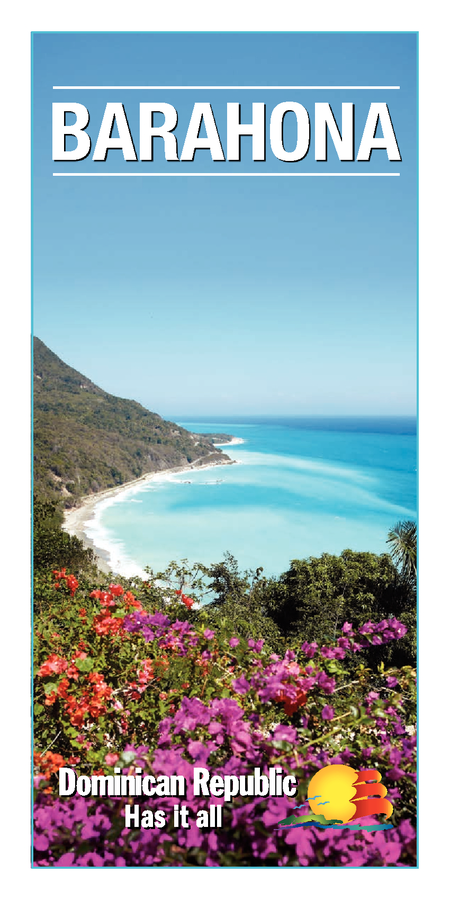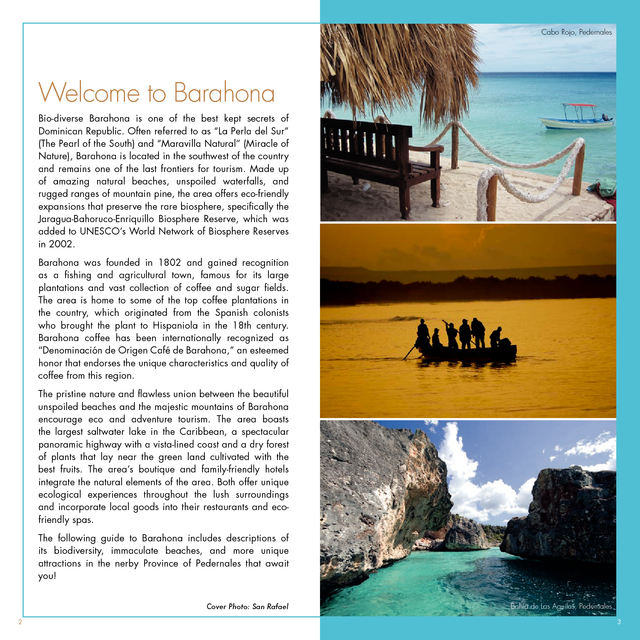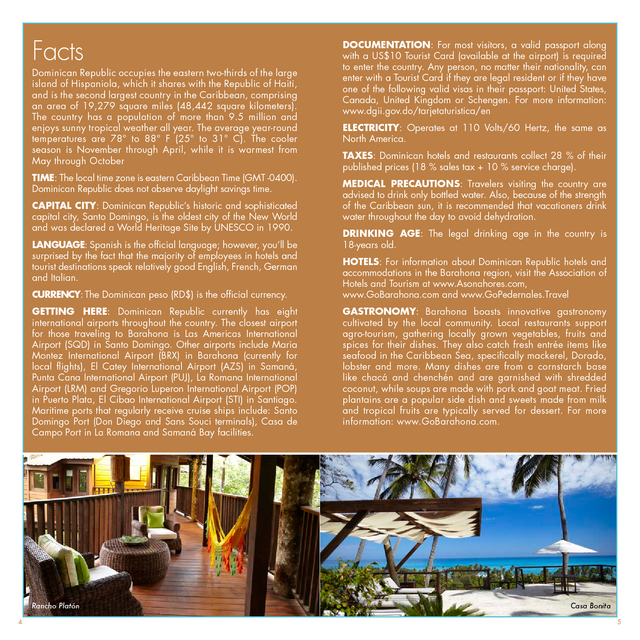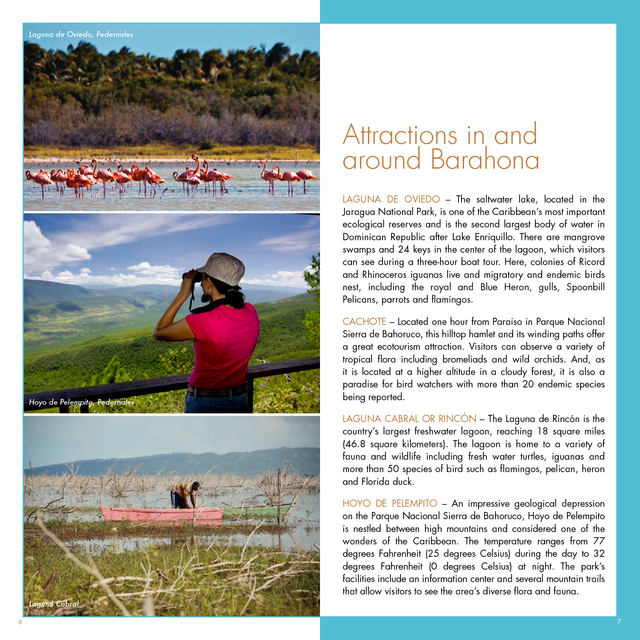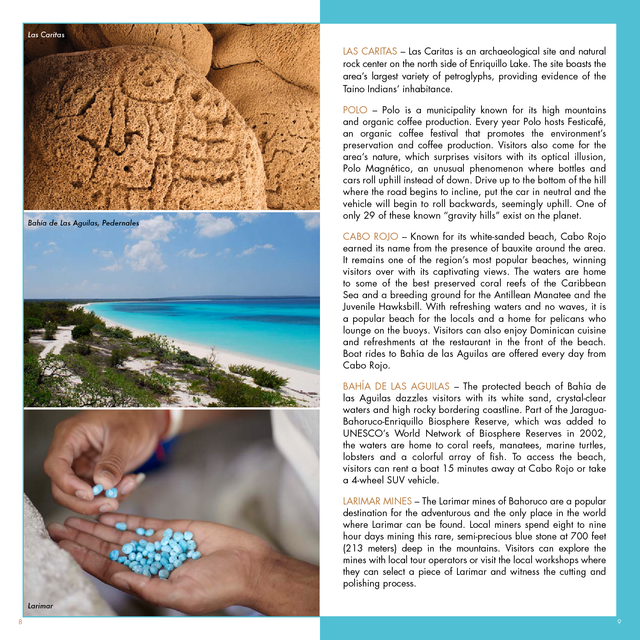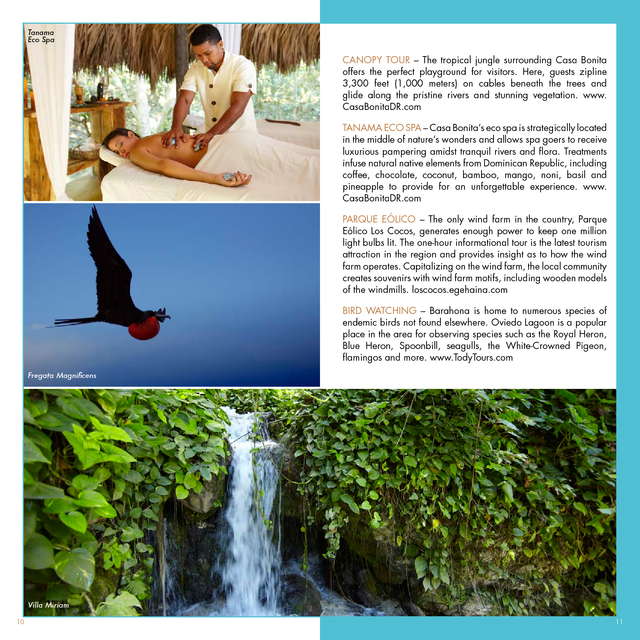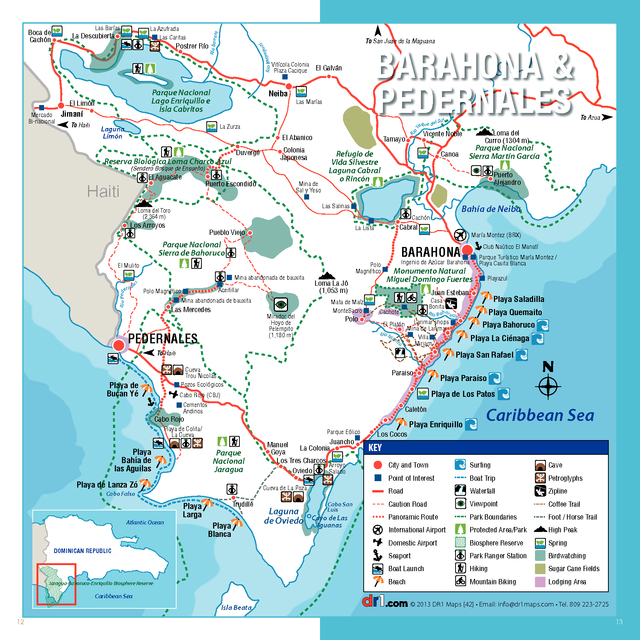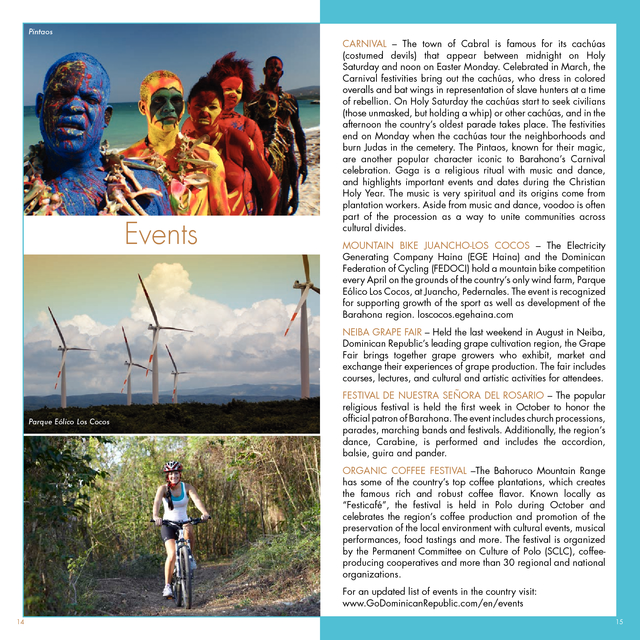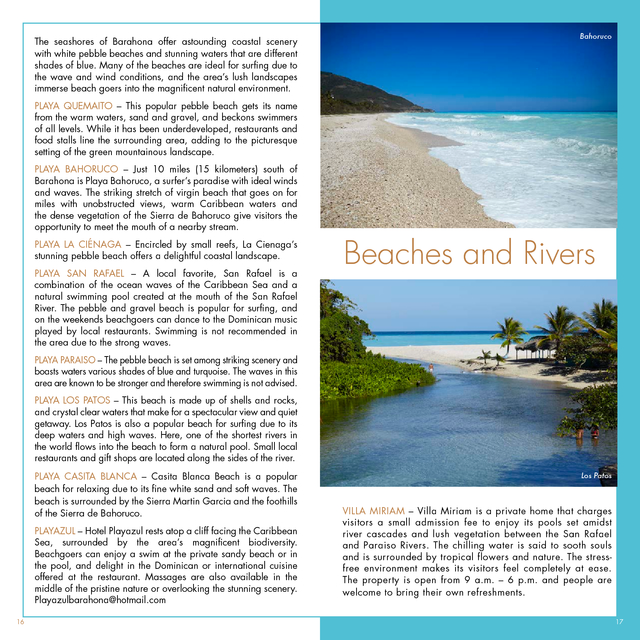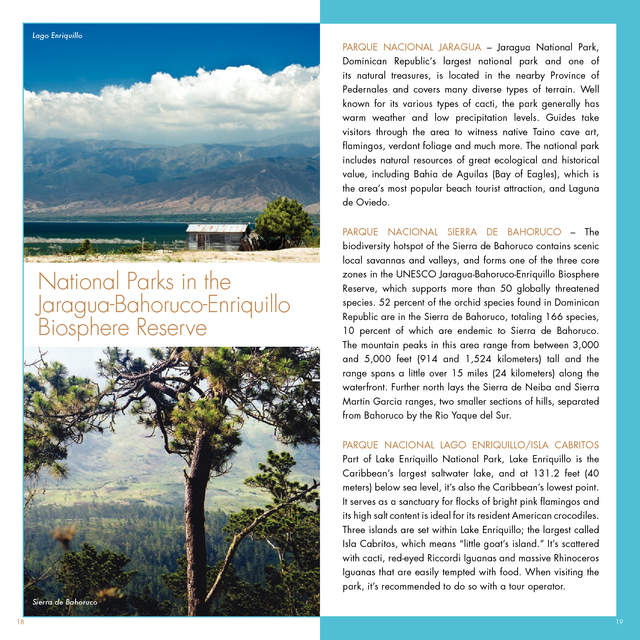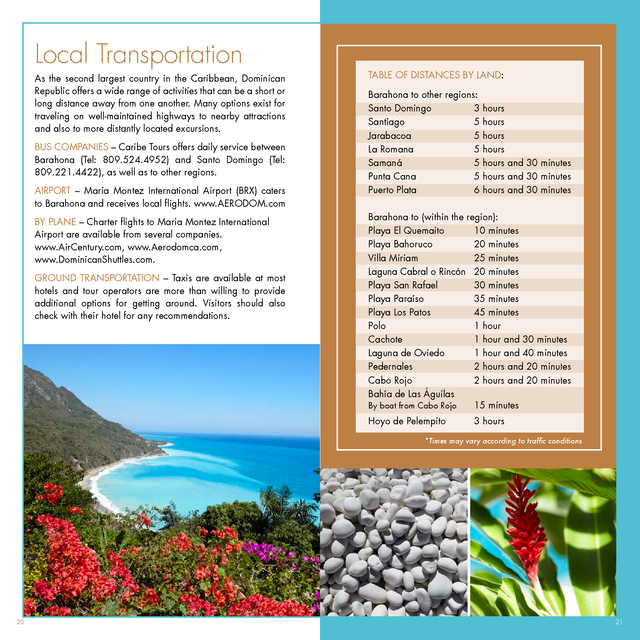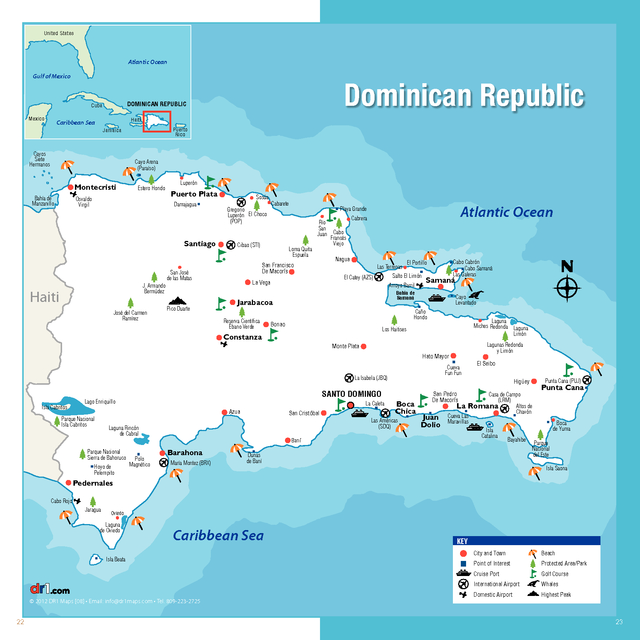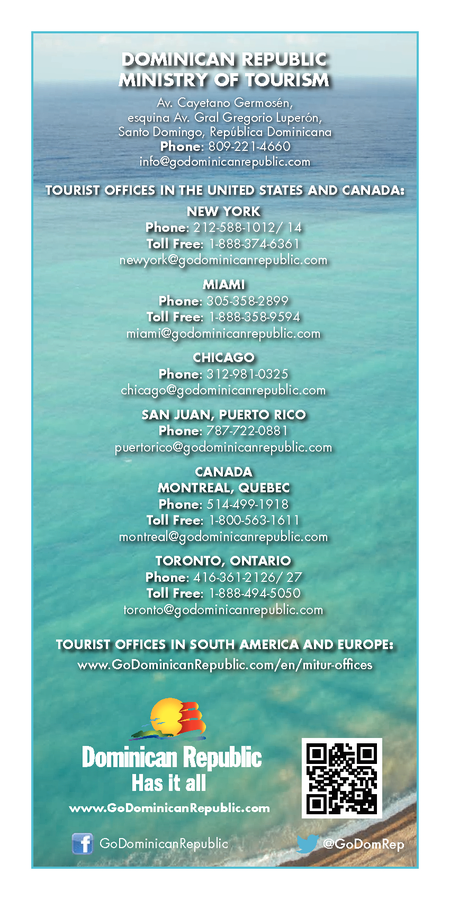




1) BARAHONA
2) Cabo Rojo, Pedernales Welcome to Barahona Bio-diverse Barahona is one of the best kept secrets of Dominican Republic. Often referred to as “La Perla del Sur” (The Pearl of the South) and “Maravilla Natural” (Miracle of Nature), Barahona is located in the southwest of the country and remains one of the last frontiers for tourism. Made up of amazing natural beaches, unspoiled waterfalls, and rugged ranges of mountain pine, the area offers eco-friendly expansions that preserve the rare biosphere, specifically the Jaragua-Bahoruco-Enriquillo Biosphere Reserve, which was added to UNESCO’s World Network of Biosphere Reserves in 2002. Barahona was founded in 1802 and gained recognition as a fishing and agricultural town, famous for its large plantations and vast collection of coffee and sugar fields. The area is home to some of the top coffee plantations in the country, which originated from the Spanish colonists who brought the plant to Hispaniola in the 18th century. Barahona coffee has been internationally recognized as “Denominación de Origen Café de Barahona,” an esteemed honor that endorses the unique characteristics and quality of coffee from this region. The pristine nature and flawless union between the beautiful unspoiled beaches and the majestic mountains of Barahona encourage eco and adventure tourism. The area boasts the largest saltwater lake in the Caribbean, a spectacular panoramic highway with a vista-lined coast and a dry forest of plants that lay near the green land cultivated with the best fruits. The area’s boutique and family-friendly hotels integrate the natural elements of the area. Both offer unique ecological experiences throughout the lush surroundings and incorporate local goods into their restaurants and ecofriendly spas. The following guide to Barahona includes descriptions of its biodiversity, immaculate beaches, and more unique attractions in the nerby Province of Pedernales that await you! Cover Photo: San Rafael 2 Bahía de Las Aguilas, Pedernales 3
3) Facts Dominican Republic occupies the eastern two-thirds of the large island of Hispaniola, which it shares with the Republic of Haiti, and is the second largest country in the Caribbean, comprising an area of 19,279 square miles (48,442 square kilometers). The country has a population of more than 9.5 million and enjoys sunny tropical weather all year. The average year-round temperatures are 78° to 88° F (25° to 31° C). The cooler season is November through April, while it is warmest from May through October TIME: The local time zone is eastern Caribbean Time (GMT -0400). Dominican Republic does not observe daylight savings time. CAPITAL CITY: Dominican Republic’s historic and sophisticated capital city, Santo Domingo, is the oldest city of the New World and was declared a World Heritage Site by UNESCO in 1990. LANGUAGE: Spanish is the official language; however, you’ll be surprised by the fact that the majority of employees in hotels and tourist destinations speak relatively good English, French, German and Italian. CURRENCY: The Dominican peso (RD$) is the official currency. GETTING HERE: Dominican Republic currently has eight international airports throughout the country. The closest airport for those traveling to Barahona is Las Americas International Airport (SQD) in Santo Domingo. Other airports include Maria Montez International Airport (BRX) in Barahona (currently for local flights), El Catey International Airport (AZS) in Samaná, Punta Cana International Airport (PUJ), La Romana International Airport (LRM) and Gregorio Luperon International Airport (POP) in Puerto Plata, El Cibao International Airport (STI) in Santiago. Maritime ports that regularly receive cruise ships include: Santo Domingo Port (Don Diego and Sans Souci terminals), Casa de Campo Port in La Romana and Samaná Bay facilities. Rancho Platón 4 DOCUMENTATION: For most visitors, a valid passport along with a US$10 Tourist Card (available at the airport) is required to enter the country. Any person, no matter their nationality, can enter with a Tourist Card if they are legal resident or if they have one of the following valid visas in their passport: United States, Canada, United Kingdom or Schengen. For more information: www.dgii.gov.do/tarjetaturistica/en ELECTRICITY: Operates at 110 Volts/60 Hertz, the same as North America. TAXES: Dominican hotels and restaurants collect 28 % of their published prices (18 % sales tax + 10 % service charge). MEDICAL PRECAUTIONS: Travelers visiting the country are advised to drink only bottled water. Also, because of the strength of the Caribbean sun, it is recommended that vacationers drink water throughout the day to avoid dehydration. DRINKING AGE: The legal drinking age in the country is 18-years old. HOTELS: For information about Dominican Republic hotels and accommodations in the Barahona region, visit the Association of Hotels and Tourism at www.Asonahores.com, www.GoBarahona.com and www.GoPedernales.Travel GASTRONOMY: Barahona boasts innovative gastronomy cultivated by the local community. Local restaurants support agro-tourism, gathering locally grown vegetables, fruits and spices for their dishes. They also catch fresh entrée items like seafood in the Caribbean Sea, specifically mackerel, Dorado, lobster and more. Many dishes are from a cornstarch base like chacá and chenchén and are garnished with shredded coconut, while soups are made with pork and goat meat. Fried plantains are a popular side dish and sweets made from milk and tropical fruits are typically served for dessert. For more information: www.GoBarahona.com. Casa Bonita 5
4) Laguna de Oviedo, Pedernales Attractions in and around Barahona LAGUNA DE OVIEDO – The saltwater lake, located in the Jaragua National Park, is one of the Caribbean’s most important ecological reserves and is the second largest body of water in Dominican Republic after Lake Enriquillo. There are mangrove swamps and 24 keys in the center of the lagoon, which visitors can see during a three-hour boat tour. Here, colonies of Ricord and Rhinoceros iguanas live and migratory and endemic birds nest, including the royal and Blue Heron, gulls, Spoonbill Pelicans, parrots and flamingos. Hoyo de Pelempito, Pedernales CACHOTE – Located one hour from Paraiso in Parque Nacional Sierra de Bahoruco, this hilltop hamlet and its winding paths offer a great ecotourism attraction. Visitors can observe a variety of tropical flora including bromeliads and wild orchids. And, as it is located at a higher altitude in a cloudy forest, it is also a paradise for bird watchers with more than 20 endemic species being reported. LAGUNA CABRAL OR RINCÓN – The Laguna de Rincón is the country’s largest freshwater lagoon, reaching 18 square miles (46.8 square kilometers). The lagoon is home to a variety of fauna and wildlife including fresh water turtles, iguanas and more than 50 species of bird such as flamingos, pelican, heron and Florida duck. HOYO DE PELEMPITO – An impressive geological depression on the Parque Nacional Sierra de Bahoruco, Hoyo de Pelempito is nestled between high mountains and considered one of the wonders of the Caribbean. The temperature ranges from 77 degrees Fahrenheit (25 degrees Celsius) during the day to 32 degrees Fahrenheit (0 degrees Celsius) at night. The park’s facilities include an information center and several mountain trails that allow visitors to see the area’s diverse flora and fauna. Laguna Cabral 6 7
5) Las Caritas LAS CARITAS – Las Caritas is an archaeological site and natural rock center on the north side of Enriquillo Lake. The site boasts the area’s largest variety of petroglyphs, providing evidence of the Taino Indians’ inhabitance. Bahía de Las Aguilas, Pedernales POLO – Polo is a municipality known for its high mountains and organic coffee production. Every year Polo hosts Festicafé, an organic coffee festival that promotes the environment’s preservation and coffee production. Visitors also come for the area’s nature, which surprises visitors with its optical illusion, Polo Magnético, an unusual phenomenon where bottles and cars roll uphill instead of down. Drive up to the bottom of the hill where the road begins to incline, put the car in neutral and the vehicle will begin to roll backwards, seemingly uphill. One of only 29 of these known “gravity hills” exist on the planet. CABO ROJO – Known for its white-sanded beach, Cabo Rojo earned its name from the presence of bauxite around the area. It remains one of the region’s most popular beaches, winning visitors over with its captivating views. The waters are home to some of the best preserved coral reefs of the Caribbean Sea and a breeding ground for the Antillean Manatee and the Juvenile Hawksbill. With refreshing waters and no waves, it is a popular beach for the locals and a home for pelicans who lounge on the buoys. Visitors can also enjoy Dominican cuisine and refreshments at the restaurant in the front of the beach. Boat rides to Bahía de las Aguilas are offered every day from Cabo Rojo. BAHÍA DE LAS AGUILAS – The protected beach of Bahía de las Aguilas dazzles visitors with its white sand, crystal-clear waters and high rocky bordering coastline. Part of the JaraguaBahoruco-Enriquillo Biosphere Reserve, which was added to UNESCO’s World Network of Biosphere Reserves in 2002, the waters are home to coral reefs, manatees, marine turtles, lobsters and a colorful array of fish. To access the beach, visitors can rent a boat 15 minutes away at Cabo Rojo or take a 4-wheel SUV vehicle. LARIMAR MINES – The Larimar mines of Bahoruco are a popular destination for the adventurous and the only place in the world where Larimar can be found. Local miners spend eight to nine hour days mining this rare, semi-precious blue stone at 700 feet (213 meters) deep in the mountains. Visitors can explore the mines with local tour operators or visit the local workshops where they can select a piece of Larimar and witness the cutting and polishing process. Larimar 8 9
6) Tanama Eco Spa CANOPY TOUR – The tropical jungle surrounding Casa Bonita offers the perfect playground for visitors. Here, guests zipline 3,300 feet (1,000 meters) on cables beneath the trees and glide along the pristine rivers and stunning vegetation. www. CasaBonitaDR.com TANAMA ECO SPA – Casa Bonita’s eco spa is strategically located in the middle of nature’s wonders and allows spa goers to receive luxurious pampering amidst tranquil rivers and flora. Treatments infuse natural native elements from Dominican Republic, including coffee, chocolate, coconut, bamboo, mango, noni, basil and pineapple to provide for an unforgettable experience. www. CasaBonitaDR.com PARQUE EÓLICO – The only wind farm in the country, Parque Eólico Los Cocos, generates enough power to keep one million light bulbs lit. The one-hour informational tour is the latest tourism attraction in the region and provides insight as to how the wind farm operates. Capitalizing on the wind farm, the local community creates souvenirs with wind farm motifs, including wooden models of the windmills. loscocos.egehaina.com BIRD WATCHING – Barahona is home to numerous species of endemic birds not found elsewhere. Oviedo Lagoon is a popular place in the area for observing species such as the Royal Heron, Blue Heron, Spoonbill, seagulls, the White-Crowned Pigeon, flamingos and more. www.TodyTours.com Fregata Magnificens Villa Miriam 10 11
7) ero Jimaní Neiba BARAHONA & PEDERNALES El Galván Las Marías La Zurza Laguna Limón El Abanico Reserva Biológica Loma Charco Azul Duvergé Tamayo Colonia Japonesa (Sendero Bosque de Ensueño) El Aguacate Haiti Puerto Escondido Mina de Sal y Yeso Puerto Alejandro Bahía de Neiba Cabral María Montez (BRX) Mina abandonada de bauxita es Aceitillar Mina abandonada de bauxita Las Mercedes Mirador del Hoyo de Pelempito (1,180 m) Polo Magnético Loma La Jó (1,053 m) Mata de Maíz MonteSacro Polo Ingenio de Azúcar Barahona Monumento Natural Miguel Domingo Fuertes Parque Turístico María Montez / Playa Casita Blanca Playazul Juan Esteban iz Playa Quemaito R í o B ahor u co Larimar shops Mina de Larimar Villa Miriam El Platón R ío N Playa Saladilla Casa Bonita Cachote i to a PEDERNALES To Haiti Playa Bahoruco Playa La Ciénaga Playa San Rafael Cueva Trou Nicolás Pozos Ecológicos Playa de Bucan Yé Club Naútico El Manatí BARAHONA El Mulito Polo Magnético Parque Nacional Sierra Martín García Canoa La Lista Pueblo Viejo To Azua Loma del Curro (1304 m) Vicente Noble Refugio de Vida Silvestre Laguna Cabral o Rincón Parque Nacional Sierra de Bahoruco R io Ped Su Cachón Los Arroyos l i Las Salinas Loma del Toro (2,364 m) a ern l aque d e oY To Haiti Vitícola Colonia Plaza Cacique R Mercado Bi-nacional al Parque Nacional Lago Enriquillo e Isla Cabritos El Limón To San Juan de la Maguana gu R i o M aya Postrer Río r La Azufrada Las Caritas La Descubierta Rio Barr Las Barías Boca de Cachón Paraiso Cementos Andinos Caletón Cabo Rojo Playa de Colita/ La Cueva Playa Bahía de las Aguilas Playa Paraiso Playa de Los Patos Cabo Rojo (CBJ) Parque Eólico Parque Nacional Jaragua Juancho Manuel La Colonia Goya Los Tres Charcos Arroyo Oviedo Salado Playa Enriquillo Caribbean Sea Los Cocos KEY Atlantic Ocean Playa Blanca DOMINICAN REPUBLIC Jaragua-Bahoruco-Enriquillo Biosphere Reserve Laguna de Oviedo Cabo San Luis Cayo de Las Iguanas Zipline Caution Road Viewpoint Coffee Trail Panoramic Route Park Boundaries Foot / Horse Trail International Airport Protected Area/Park High Peak Domestic Airport Biosphere Reserve Spring Park Ranger Station Birdwatching Hiking Sugar Cane Fields Beach Trudillé Playa Larga Petroglyphs Waterfall Boat Launch Cabo Falso Cave Boat Trip Road Cueva de La Poza Surfing Point of Interest Seaport Playa de Lanza Zó City and Town Mountain Biking Lodging Area Caribbean Sea Isla Beata 12 © 2013 DR1 Maps [42] • Email: info@dr1maps.com • Tel. 809 223-2725 13
8) Pintaos Events CARNIVAL – The town of Cabral is famous for its cachúas (costumed devils) that appear between midnight on Holy Saturday and noon on Easter Monday. Celebrated in March, the Carnival festivities bring out the cachúas, who dress in colored overalls and bat wings in representation of slave hunters at a time of rebellion. On Holy Saturday the cachúas start to seek civilians (those unmasked, but holding a whip) or other cachúas, and in the afternoon the country’s oldest parade takes place. The festivities end on Monday when the cachúas tour the neighborhoods and burn Judas in the cemetery. The Pintaos, known for their magic, are another popular character iconic to Barahona’s Carnival celebration. Gaga is a religious ritual with music and dance, and highlights important events and dates during the Christian Holy Year. The music is very spiritual and its origins come from plantation workers. Aside from music and dance, voodoo is often part of the procession as a way to unite communities across cultural divides. MOUNTAIN BIKE JUANCHO-LOS COCOS – The Electricity Generating Company Haina (EGE Haina) and the Dominican Federation of Cycling (FEDOCI) hold a mountain bike competition every April on the grounds of the country’s only wind farm, Parque Eólico Los Cocos, at Juancho, Pedernales. The event is recognized for supporting growth of the sport as well as development of the Barahona region. loscocos.egehaina.com NEIBA GRAPE FAIR – Held the last weekend in August in Neiba, Dominican Republic’s leading grape cultivation region, the Grape Fair brings together grape growers who exhibit, market and exchange their experiences of grape production. The fair includes courses, lectures, and cultural and artistic activities for attendees. Parque Eólico Los Cocos FESTIVAL DE NUESTRA SEÑORA DEL ROSARIO – The popular religious festival is held the first week in October to honor the official patron of Barahona. The event includes church processions, parades, marching bands and festivals. Additionally, the region’s dance, Carabine, is performed and includes the accordion, balsie, guira and pander. ORGANIC COFFEE FESTIVAL –The Bahoruco Mountain Range has some of the country’s top coffee plantations, which creates the famous rich and robust coffee flavor. Known locally as “Festicafé”, the festival is held in Polo during October and celebrates the region’s coffee production and promotion of the preservation of the local environment with cultural events, musical performances, food tastings and more. The festival is organized by the Permanent Committee on Culture of Polo (SCLC), coffeeproducing cooperatives and more than 30 regional and national organizations. For an updated list of events in the country visit: www.GoDominicanRepublic.com/en/events 14 15
9) The seashores of Barahona offer astounding coastal scenery with white pebble beaches and stunning waters that are different shades of blue. Many of the beaches are ideal for surfing due to the wave and wind conditions, and the area’s lush landscapes immerse beach goers into the magnificent natural environment. Bahoruco PLAYA QUEMAITO – This popular pebble beach gets its name from the warm waters, sand and gravel, and beckons swimmers of all levels. While it has been underdeveloped, restaurants and food stalls line the surrounding area, adding to the picturesque setting of the green mountainous landscape. PLAYA BAHORUCO – Just 10 miles (15 kilometers) south of Barahona is Playa Bahoruco, a surfer’s paradise with ideal winds and waves. The striking stretch of virgin beach that goes on for miles with unobstructed views, warm Caribbean waters and the dense vegetation of the Sierra de Bahoruco give visitors the opportunity to meet the mouth of a nearby stream. PLAYA LA CIÉNAGA – Encircled by small reefs, La Cienaga’s stunning pebble beach offers a delightful coastal landscape. PLAYA SAN RAFAEL – A local favorite, San Rafael is a combination of the ocean waves of the Caribbean Sea and a natural swimming pool created at the mouth of the San Rafael River. The pebble and gravel beach is popular for surfing, and on the weekends beachgoers can dance to the Dominican music played by local restaurants. Swimming is not recommended in the area due to the strong waves. Beaches and Rivers PLAYA PARAISO – The pebble beach is set among striking scenery and boasts waters various shades of blue and turquoise. The waves in this area are known to be stronger and therefore swimming is not advised. PLAYA LOS PATOS – This beach is made up of shells and rocks, and crystal clear waters that make for a spectacular view and quiet getaway. Los Patos is also a popular beach for surfing due to its deep waters and high waves. Here, one of the shortest rivers in the world flows into the beach to form a natural pool. Small local restaurants and gift shops are located along the sides of the river. PLAYA CASITA BLANCA – Casita Blanca Beach is a popular beach for relaxing due to its fine white sand and soft waves. The beach is surrounded by the Sierra Martin Garcia and the foothills of the Sierra de Bahoruco. PLAYAZUL – Hotel Playazul rests atop a cliff facing the Caribbean Sea, surrounded by the area’s magnificent biodiversity. Beachgoers can enjoy a swim at the private sandy beach or in the pool, and delight in the Dominican or international cuisine offered at the restaurant. Massages are also available in the middle of the pristine nature or overlooking the stunning scenery. Playazulbarahona@hotmail.com 16 Los Patos VILLA MIRIAM – Villa Miriam is a private home that charges visitors a small admission fee to enjoy its pools set amidst river cascades and lush vegetation between the San Rafael and Paraiso Rivers. The chilling water is said to sooth souls and is surrounded by tropical flowers and nature. The stressfree environment makes its visitors feel completely at ease. The property is open from 9 a.m. – 6 p.m. and people are welcome to bring their own refreshments. 17
10) Lago Enriquillo National Parks in the Jaragua-Bahoruco-Enriquillo Biosphere Reserve PARQUE NACIONAL JARAGUA – Jaragua National Park, Dominican Republic’s largest national park and one of its natural treasures, is located in the nearby Province of Pedernales and covers many diverse types of terrain. Well known for its various types of cacti, the park generally has warm weather and low precipitation levels. Guides take visitors through the area to witness native Taino cave art, flamingos, verdant foliage and much more. The national park includes natural resources of great ecological and historical value, including Bahia de Aguilas (Bay of Eagles), which is the area’s most popular beach tourist attraction, and Laguna de Oviedo. PARQUE NACIONAL SIERRA DE BAHORUCO – The biodiversity hotspot of the Sierra de Bahoruco contains scenic local savannas and valleys, and forms one of the three core zones in the UNESCO Jaragua-Bahoruco-Enriquillo Biosphere Reserve, which supports more than 50 globally threatened species. 52 percent of the orchid species found in Dominican Republic are in the Sierra de Bahoruco, totaling 166 species, 10 percent of which are endemic to Sierra de Bahoruco. The mountain peaks in this area range from between 3,000 and 5,000 feet (914 and 1,524 kilometers) tall and the range spans a little over 15 miles (24 kilometers) along the waterfront. Further north lays the Sierra de Neiba and Sierra Martin Garcia ranges, two smaller sections of hills, separated from Bahoruco by the Rio Yaque del Sur. PARQUE NACIONAL LAGO ENRIQUILLO/ISLA CABRITOS Part of Lake Enriquillo National Park, Lake Enriquillo is the Caribbean’s largest saltwater lake, and at 131.2 feet (40 meters) below sea level, it’s also the Caribbean’s lowest point. It serves as a sanctuary for flocks of bright pink flamingos and its high salt content is ideal for its resident American crocodiles. Three islands are set within Lake Enriquillo; the largest called Isla Cabritos, which means “little goat’s island.” It’s scattered with cacti, red-eyed Riccordi Iguanas and massive Rhinoceros Iguanas that are easily tempted with food. When visiting the park, it’s recommended to do so with a tour operator. Sierra de Bahoruco 18 19
11) Local Transportation As the second largest country in the Caribbean, Dominican Republic offers a wide range of activities that can be a short or long distance away from one another. Many options exist for traveling on well-maintained highways to nearby attractions and also to more distantly located excursions. BUS COMPANIES – Caribe Tours offers daily service between Barahona (Tel: 809.524.4952) and Santo Domingo (Tel: 809.221.4422), as well as to other regions. AIRPORT – Maria Montez International Airport (BRX) caters to Barahona and receives local flights. www.AERODOM.com BY PLANE – Charter flights to Maria Montez International Airport are available from several companies. www.AirCentury.com, www.Aerodomca.com, www.DominicanShuttles.com. GROUND TRANSPORTATION – Taxis are available at most hotels and tour operators are more than willing to provide additional options for getting around. Visitors should also check with their hotel for any recommendations. TABLE OF DISTANCES BY LAND: Barahona to other regions: Santo Domingo 3 hours Santiago 5 hours Jarabacoa 5 hours La Romana 5 hours Samaná 5 hours and 30 minutes Punta Cana 5 hours and 30 minutes Puerto Plata 6 hours and 30 minutes Barahona to (within the region): Playa El Quemaito 10 minutes Playa Bahoruco 20 minutes Villa Miriam 25 minutes Laguna Cabral o Rincón 20 minutes Playa San Rafael 30 minutes Playa Paraíso 35 minutes Playa Los Patos 45 minutes Polo 1 hour Cachote 1 hour and 30 minutes Laguna de Oviedo 1 hour and 40 minutes Pedernales 2 hours and 20 minutes Cabo Rojo 2 hours and 20 minutes Bahía de Las Águilas By boat from Cabo Rojo 15 minutes Hoyo de Pelempito 3 hours *Times may vary according to traffic conditions 20 21
12) United States Atlantic Ocean Gulf of Mexico Dominican Republic DOMINICAN REPUBLIC Cuba Mexico Haiti Caribbean Sea Puerto Rico Jamaica Cayos Siete Hermanos Cayo Arena (Paraíso) Montecristi Bahía de Manzanillo Estero Hondo Osvaldo Virgil Luperón Puerto Plata Damajagua Santiago Sosúa Gregorio Luperón El Choco (POP) José del Carmen Ramírez Pico Duarte Loma Quita Espuela San Francisco De Macorís La Vega J. Armando Bermúdez Atlantic Ocean Playa Grande Río San Juan Cibao (STI) San José de las Matas Haiti Cabarete Cabrera Cabo Francés Viejo Nagua Las Terrenas Arroyo Barril Samaná Bahía de Samaná Jarabacoa Reserva Científica Ébano Verde Cabo Cabrón Cabo Samaná Las Galeras El Portillo Salto El Limón El Catey (AZS) Cayo Levantado Caño Hondo Bonao Laguna Miches Redonda Laguna Limón Los Haitises Constanza Lagunas Redonda y Limón Monte Plata Hato Mayor Cueva Fun Fun La Isabela (JBQ) Isla Cabritos La Caleta Azua Parque Nacional Isla Cabritos San Cristóbal Parque Nacional Sierra de Bahoruco Hoyo de Pelempito Polo Magnético Boca Chica Las Américas (SDQ) Laguna Rincón de Cabral Baní Barahona María Montez (BRX) Punta Cana (PUJ) Higüey SANTO DOMINGO Lago Enriquillo El Seibo San Pedro De Macorís Juan Dolio Casa de Campo (LRM) Altos de La Romana Chavón Cueva Las Maravillas Isla Catalina Bayahibe Punta Cana Boca de Yuma Parque Nacional del Este Dunas de Baní Isla Saona Pedernales Cabo Rojo Jaragua Oviedo Laguna de Oviedo Caribbean Sea KEY 22 Beach Point of Interest Protected Area/Park Golf Course International Airport © 2012 DR1 Maps [08] • Email: info@dr1maps.com • Tel. 809-223-2725 City and Town Cruise Port Isla Beata Whales Domestic Airport Highest Peak 23
13) DOMINICAN REPUBLIC MINISTRY OF TOURISM Av. Cayetano Germosén, esquina Av. Gral Gregorio Luperón, Santo Domingo, República Dominicana Phone: 809-221-4660 info@godominicanrepublic.com TOURIST OFFICES IN THE UNITED STATES AND CANADA: NEW YORK Phone: 212-588-1012/ 14 Toll Free: 1-888-374-6361 newyork@godominicanrepublic.com MIAMI Phone: 305-358-2899 Toll Free: 1-888-358-9594 miami@godominicanrepublic.com CHICAGO Phone: 312-981-0325 chicago@godominicanrepublic.com SAN JUAN, PUERTO RICO Phone: 787-722-0881 puertorico@godominicanrepublic.com CANADA MONTREAL, QUEBEC Phone: 514-499-1918 Toll Free: 1-800-563-1611 montreal@godominicanrepublic.com TORONTO, ONTARIO Phone: 416-361-2126/ 27 Toll Free: 1-888-494-5050 toronto@godominicanrepublic.com TOURIST OFFICES IN SOUTH AMERICA AND EUROPE: www.GoDominicanRepublic.com/en/mitur-offices www.GoDominicanRepublic.com GoDominicanRepublic @GoDomRep


